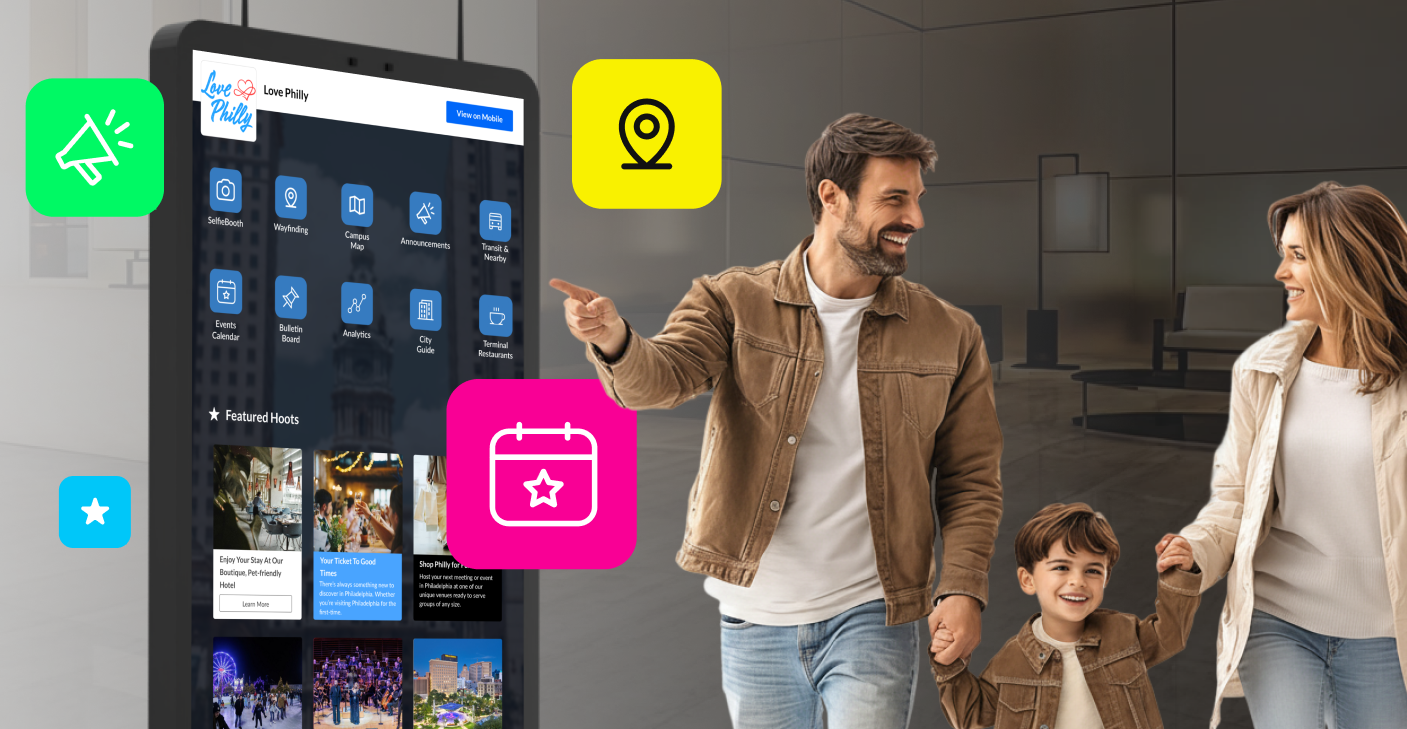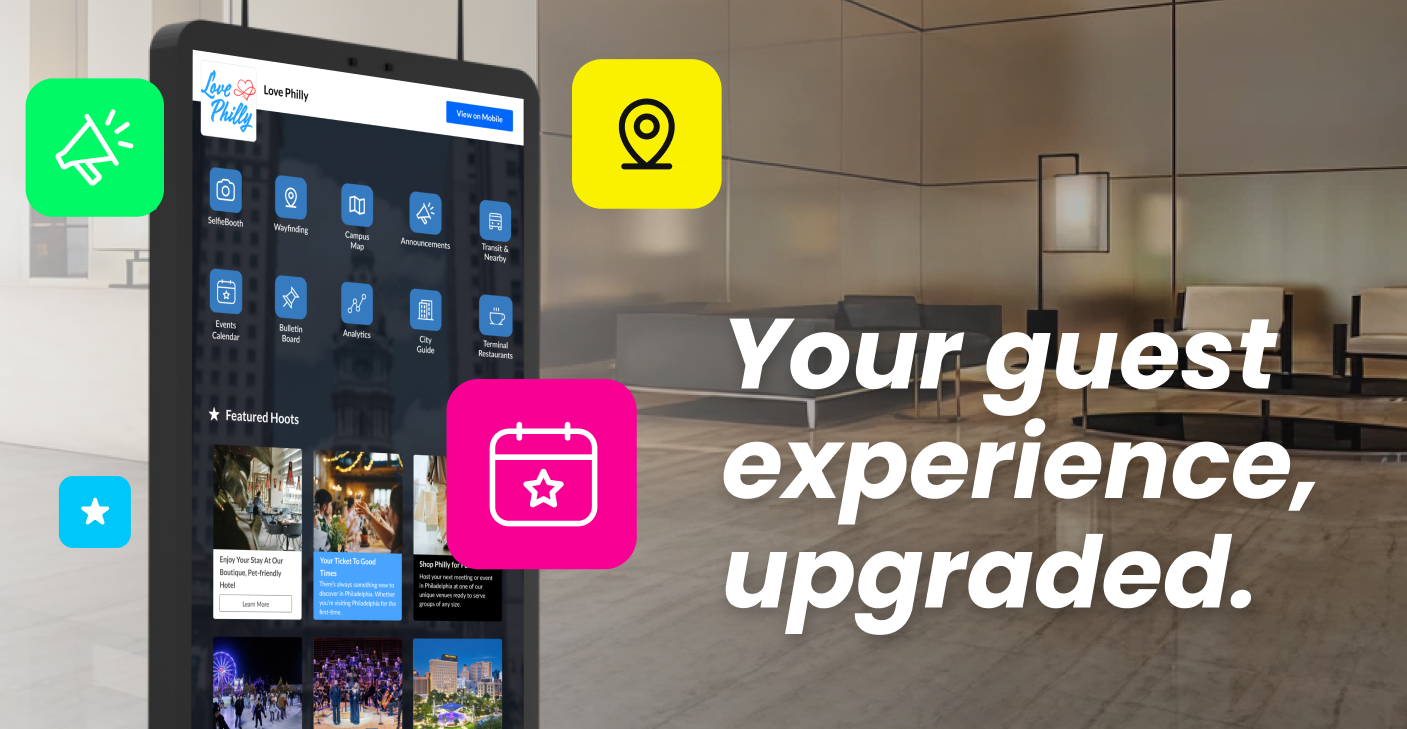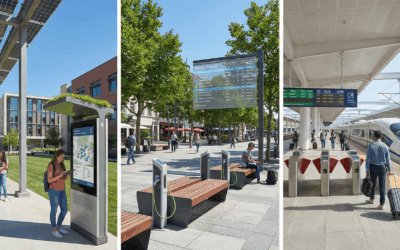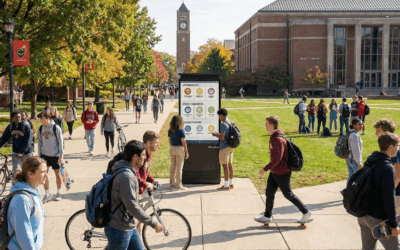The Gap Nobody Talks About
Every September, a freshman wanders a campus clutching a crumpled paper map. In December, a weary hotel receptionist fields the same questions about Wi-Fi, spa hours, and taxi bookings for the hundredth time. And at the local visitor center, a tourist rifles through outdated brochures, wondering why nothing feels personal or up-to-date.
Different industries. The same problem.
We call it the visitor experience gap — the widening disconnect between what today’s audiences expect and what institutions actually deliver.
And here’s the kicker: the fourth quarter of the year is when this gap either gets closed or cemented for another cycle. Schools finalize their spring budgets, hotels test their readiness for the holiday surge, and tourism boards lock in next year’s campaigns.
For partners, Q4 isn’t just a sales window. It’s the moment to position interactive kiosks not as gadgets, but as the missing infrastructure for trust, engagement, and growth.
Why Q4 Is a Decision Point
Timing isn’t a detail — it’s the strategy.
- Schools & Universities review IT and student services budgets in Q4 to prepare for spring intake. This is when tech that improves student life gets prioritized.
- Hotels face their busiest travel season. Pain points — long check-in lines, missed upsells, guest frustrations — are most visible.
- Tourism Boards & DMOs begin drafting 2025 campaigns. Visitor engagement, local partnerships, and new revenue models are at the center of their plans.
📊 The Numbers Behind the Moment
- Global edtech spend will reach $404B by 2025 (HolonIQ).
- 78% of travelers prefer hotels with self-service options (Skift, 2024).
- DMOs report 65% of visitors use in-destination digital tools to plan activities (Destination Analysts, 2024).
Q4 is when these industries decide whether they’ll adapt — or fall further behind.

Schools: A Digital-Native Generation on Analog Campuses
Picture this: A new student, 18 years old, steps onto campus for orientation. She’s part of Gen Z — a digital-native generation that grew up on smartphones. Yet within minutes, she’s lost trying to find the chemistry building. She checks a static map pinned to a wall. It doesn’t help. She arrives late, stressed, and less confident about her new environment.
It seems small, but multiply it by thousands of freshmen across the country. This is more than a wayfinding problem. It’s a trust problem.
Interactive kiosks change that story.
- Wayfinding: Dynamic, searchable campus maps that eliminate confusion.
- Engagement: Real-time updates on clubs, events, and deadlines.
- Monetization: Local businesses — coffee shops, gyms, bookstores — advertise directly to students.
- Safety: Emergency alerts pushed instantly to screens across campus.
📊 Research Insight: According to Educause, 68% of students expect digital tools to be seamlessly integrated into their daily campus experience. Campuses that ignore this expectation risk appearing outdated and unresponsive.

Hotels: The War Between OTAs and Guest Loyalty
Now picture a hotel lobby in December. A young couple arrives after a long flight. They’re greeted by a line at reception. The front-desk staff is friendly but overwhelmed, juggling check-ins, phone calls, and endless guest questions.
Meanwhile, the couple books a spa appointment through an OTA app instead of the hotel directly. The hotel loses both control and revenue.
This is the silent battle hotels fight daily: OTAs win convenience, hotels lose loyalty.
Interactive kiosks turn the tide.
- Digital Concierge: Guests discover spa hours, restaurant menus, and local tours on their own.
- Upselling: Spa packages, dining deals, and upgrades are promoted at eye level, 24/7.
- Data Ownership: Hotels gather guest preferences instead of ceding them to third-party platforms.
- Efficiency: Staff focus on hospitality, not routine queries.
📊 Research Insight: PwC reports that 73% of hoteliers rank “improving guest experience with digital tools” as a top strategic priority for the next 12 months.

Tourism & DMOs: Visitor Centers Nobody Visits
Visit a traditional tourism office and you’ll see it: stacks of glossy brochures, a few posters, maybe a desk clerk. But travelers aren’t picking up brochures anymore. They’re Googling, scrolling TikTok, or checking apps.
The result? Visitor centers risk irrelevance at the very moment they’re supposed to be essential.
Interactive kiosks rewrite the role of DMOs.
- Dynamic Wayfinding: Real-time maps of attractions, transit, and events.
- Local Economic Impact: Small businesses gain visibility through ad placements.
- Visitor Analytics: Boards understand demographics, interests, and travel flows.
- Recurring Revenue: Ad inventory transforms kiosks into self-sustaining assets.
📊 Research Insight: In 2023, U.S. travelers spent $1.2 trillion domestically (USTravel.org). The destinations that capture and guide that spend will win.

The Partner Playbook for Q4
For partners, the opportunity is clear. But how do you turn it into wins?
- Start with Pain, Not Product:
Don’t lead with hardware specs. Lead with empathy. “Are freshmen still getting lost?” “Are you tired of OTAs owning your guest data?” “Do visitors ignore your brochures?” - Frame Kiosks as Infrastructure:
These aren’t gadgets. They’re engagement backbones that connect people, places, and services. - Emphasize ROI:
- Ad revenue streams for schools and DMOs.
- Upsells for hotels.
- Analytics for smarter campaigns.
- Create Urgency:
Decisions made in Q4 decide whether kiosks are deployed in spring 2025 or delayed another year.

Don’t Let Another Year Slip By
The visitor experience gap is real — and widening. Students expect digital-first campuses. Travelers demand seamless hotel experiences. Tourists want real-time, personalized recommendations.
Institutions that wait another year will fall further behind. Institutions that act now will lead.
For partners, Q4 is not a quarter to sit out. It’s the chance to put interactive kiosks at the center of 2025 budgets — and position yourself as the one who closed the gap.




